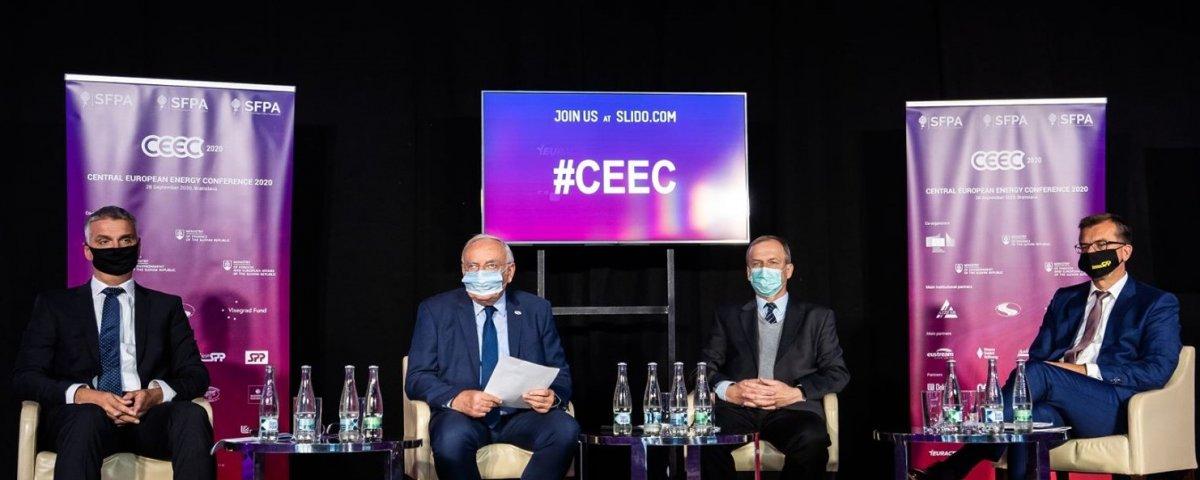NAFTA a partner in the 2020 Central European Energy Conference
Because of measures put in place to prevent the spread of the COVID-19, the Central European Energy Conference was held online this year with no public audience. At the gas industry panel conference, Mr. Bartošovič talked about how underground gas storage facilities can play a major role in energy storage as part of the natural gas infrastructure. At its current European storage capacity, up to 34 TWh of renewable energy could be stored.
Even though the European Union’s target for achieving zero greenhouse gas emissions by 2050 is clear, the way forward to reach this goal is less so. He considered the updated 2030 target of a 55% drop compared to 1990 to be “extremely ambitious” and requiring a great deal of effort.
Mr. Bartošovič recalled the three pillars of future carbon-free energy - electricity generated solely from renewable energy sources (RES), hydrogen and renewable methane. Speaking about them, he pointed out that existing infrastructure plays an important role for gas storage facility operators. Putting it in concrete terms, he commented,"In the position energy carriers are today, hydrogen and renewal methane are definitely up to date”.
In his view, while the first phase of the Europe 2024 hydrogen strategy is extremely ambitious and although there are a number of technical solutions and innovations today, hydrogen has still not achieved such levels for it to be used in large volumes.
The NAFTA chief executive presented a project for greening methane and simultaneously utilizing the entire natural gas infrastructure chain, including gas transit and distribution pipelines along with storage facilities. "This project had already started up in 2014 with the storage a mixture of methane and hydrogen in Austria, put together by a relatively large consortium headed by RAG and with the participation of several universities and corporations in the sector,” Mr. Bartošovič said, adding that there had been two phases comprising laboratory and actual testing which sought to store a mixture of methane and hydrogen.
Because RES cannot be stably supplied, delivered output declines sharply when the sky is overcast or the wind stops blowing. It is often the case that RES generates electricity when it is not needed because of minimal demand. He pointed out the two simple alternatives currently available. Either to switch off the source or sell the energy at a negative price.
"An underground gas storage facility would store the energy, while conversion would work on the principle that, when there is no real demand for electricity from RES, electrolysis would convert it into hydrogen to be mixed with natural gas.” Mr. Bartošovič went on to explain that the mixture NAFTA had tested was 90% methane and 10% hydrogen. “We injected it into an underground gas storage facility, a small excavated reservoir, and then produced the mixture.”
He continued by mentioning that the mixture of green methane could be used in any of three ways. One alternative would be to return it to the gas network for use by end customers, households, companies and electricity producers.
Another option would be the electricity grid. “We have also examined theoretically the option of generating steam-gas cycle electricity near underground storage sites, where the mixture could be burned at once and produce electricity to supply the grid and for delivery to end customers.” He also mentioned the third alternative of mobility and using the mixture in transport.
Mr. Bartošovič stressed the capacity of each solution. "Looking at all the energy projects where batteries would store the energy, or the various pump-storage power generating modules, their output is extremely small. Taking into account that the EU has approximately 103 billion cubic meters of storage capacity mixing 10% hydrogen in methane lets us store up to 34 TWh of renewable energy.” The CEO concluded by mentioning that NAFTA’s expansion into Bavaria and the acquisition of three storage facilities there had made it Europe’s sixth largest natural gas storage operator.
origin: www.slovgas.sk
 partner SEK
partner SEK
About Us
company profile of NAFTA
NAFTA is an international company with extensive experience in natural gas storage and underground facility development in Slovakia. It is also Slovakia’s leader in exploration of hydrocarbons. In Europe, the company actively operates gas storage facilities, produces hydrocarbons and participates in renewable energy storage projects. In addition to Slovakia, the company is present in the Czech Republic, Germany, Great Britain, Austria, and Ukraine.
More
NAFTA provides development, engineering and advisory services for facilities with overall storage capacity of approximately 64 TWh.
Company history